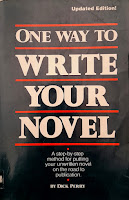Over two decades ago, I came across the book ‘One way to write your novel’ by Dick Perry, while browsing my father’s bookshelves. I started reading, and found it quirky, interesting, and instructive. I had no real plans to write a novel at the time, but could see that the author’s structured method could be quite helpful, if one’s mind worked that way. A decade or so later, browsing a second-hand store, I came across this book and decided I would like my own copy.
However, it’s taken me until a few months ago to pick it up to re-read. All I remembered was that it was a way of organising one’s thoughts, and planning the outline of a novel before embarking on the actual writing. Writers are loosely categorised as ‘planners’ or ‘pantsers’ (ie those who plan in advance, or who write by the ‘seat of the pants’ (in American phraseology). I quite like unplanned writing, and thought of myself as a pantser for many years. But a few months ago I had a huge ‘aha!’ moment when I realised that in general I do a lot of planning, and that this might suit my writing style better.
‘One way to write your novel’ was first published in 1969. It was revised in 1972, apparently, and I have a sixth edition paperback, published in 1984. So inevitably there’s a lot that’s very dated and not relevant to today’s writers. But that mostly relates to technology, and to the tedium of having to retype one’s novel at least twice after the first draft. The final chapters, too, explaining about sending boxes of printouts to publishers is no longer relevant in today’s electronic era.
However, the bulk of the book is full of sound, inspiring advice to those who like to plan. The first chapter covers topics like finding time, being efficient in one’s use of time, and encouraging the reader to get going if they have ever considered writing a novel. Just thinking about it, Dick Perry assures us in his chatty style, is not going to get us anywhere.
The second chapter suggests that the first draft of a novel can be written in 100 days - not such an unlikely prospect, given that many people (including me) have attempted first drafts of novels in just 30 days with the annual NaNoWriMo project. What Dick Perry insists is that the planning must be done in advance, and the next few chapters look at what’s necessary. He begins with characters, with checklists and other suggestions about how to create interesting and believable people.
The book moves on to covering what’s involved in a novel: dialogue, setting and locations, and how to make a novel sparkle so that it stands out. None of this was new to me (even though I had entirely forgotten the specifics of this book) but I liked the way the author wrote, as if to friends, with personal commentary and plenty of humour. Finally he reaches the part which I think of as the most difficult: actually plotting the novel. He uses card indexes, another reminder that this book is over fifty years old, although of course people who prefer to draft writing by hand could follow his advice exactly. I prefer to use an application like Scrivener which has its own ‘card index’ system built in. But the principles work extremely well.
I never asked whether my late father’s one published novel was planned using this method. I don’t know if any of my previous attempts will make it to publication, or whether I might start a new one with plenty of planning in advance. I tried to use the author’s method to put some structure into one of my ‘NaNoWriMo’ draft novels written without any planning, and realised just what a good idea it might have been to plan in advance. Planning doesn’t mean there are no surprises, or that everything is known in advance. But it does help the main plot to advance, ensures that necessary subplots are mentioned in suitable places, and brings the overall story to a conclusion.
The final chapters of Dick Perry’s book cover the editing process, and again I thought there was a lot of value, even if the methods he uses (literally cutting - with scissors - and then stapling papers together) are no longer necessary. The author died in 2002, apparently, so I hope he had a chance to use computer software for some of his novels. But the content of his chapter about editing is very useful, in particular the things he mentions that budding writers should look out for.
There are parts of this book that wouldn’t be considered politically correct in today’s society, and places where he’s quite rigid in his recommendations. His example ‘story’, used throughout to illustrate the principles he writes about, is hackneyed and (at times) decidedly weird. But it makes the points well, and I’m sure I’ll dip into this book in future, maybe even reading from cover to cover again if I feel inspired to begin a new novel.
Very highly recommended, if you want a method of planning a novel, don’t mind an informal style of writing and are happy to skip or skim parts that are not relevant. It's long out of print, but is the kind of book that turns up from time to time in second-hand stores, both physical ones and online.
My other personal favourite books about writing (sadly not all in print) are:
- Writing on both sides of the brain by Henriette Anne Klauser- Bird by bird by Anne Lamott- Walking on water by Madeleine l'Engle- The five-minute writer by Margret Geraghty- Becoming a writer by Dorothea Brande- Back to creative writing school by Bridget Whelan- How to write and sell short stories by Della Galton- Writing great short stories by Margaret Lucke- Guide to fiction writing by Phyllis Whitney
Review copyright 2023 Sue's Book Reviews

No comments:
Post a Comment